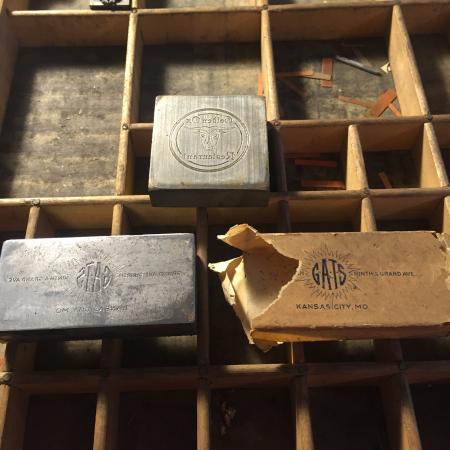Terminology/usage
Is there a particular term for when the type block has the characters recessed and the surrounding area is type high? Was this for doing two color work or was it to have the characters be white space? It is curious to note that the wrapper for the “GATS” block has raised ink printing.

IMG_2620.jpeg

IMG_2619.jpg
My guess is that these are for Intaglio, not letterpress.
A special type of Intaglio, Gravure, this can be printed on Carver or Cronite Presses.
To print those, the entire plate is inked with a paste type intaglio ink. Then the ink is scraped off the top surface of the plate, leaving ink only in the recessed areas. Then paper is placed on the plate in an intaglio press, and with a lot of force the paper is pressed down onto the plate. It leaves a raised image on the paper, partly because the paper is forced down into the recessed areas of the plate, and partly because there is so much ink deposited on the paper.
In answer to your original question, if this was a letterpress plate where the background printed and the letters remained white (or the color of the paper), that would be called a reverse. We also sometimes say that the letters are reversed out, or dropped out (of the background ink color).
These are the older style of steel stamping dies used in engraving. A combination of hand cutting and acid etching through a resist was used to create the designs and lettering. The paper wrapper was with the printed, or properly engraved image of the plate, and that was how these were stored for protection and identification. These would not be used in gravure work—similar but not at all the same process, and the ink is wiped, not scraped, from the surface by paper on a roll called die wipe. I have a couple of this same style of dies in my desk drawer to show visitors. My experience dates from the 1960s when I ran a steel die shop in San Francisco. This type of die was created on soft steel, when the work was ok or approved,the steel was hardened for the actual engraving. Current work in this field is usually done now on copper plates instead of these half inch thick steel dies.
I have several of these that are stamped on the side with TIFFANY & Co.which I believe means there were dies for making engraved stationery through the store Tiffany in NYC for the various clients.
Thanks for your correction to my post, Fritz. I worked in gravure at one time, but as you say, it was not at all the same process as with this type of die. I did not know that the ink was wiped off by paper on a roll. I assumed, wrongly, that it was wiped by a doctor blade, as in gravure.
Thanks for feedback. Of the several hundred dies found at this sale, most are monograms and fraternity coats of arms and thus I imagine they are for stationery as “franklincreations” suggested. I would guess that this beastly stamper with the trade name Kelton, was used with them?
IMG_2625.jpg
Not quite—most U.S. commercial engravers use this press, a Cronite, or a version of it:
http://thomasauction.hibid.com/lot/52675-19877-20930/hi-speed-cronite-ma...
and if they use a hand fed press, a Baby Carver or a Modern, as shown in this video:
https://www.youtube.com/watch?v=yOc-_wF6smk
Those machines look fairly modern and some of the dies I found were from just at the turn of the century. I won’t vouch for its accuracy, but this article suggests the Kelton was used for stationery, etc.
http://www.ephemerasociety.org/blog/?p=85